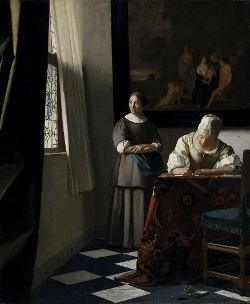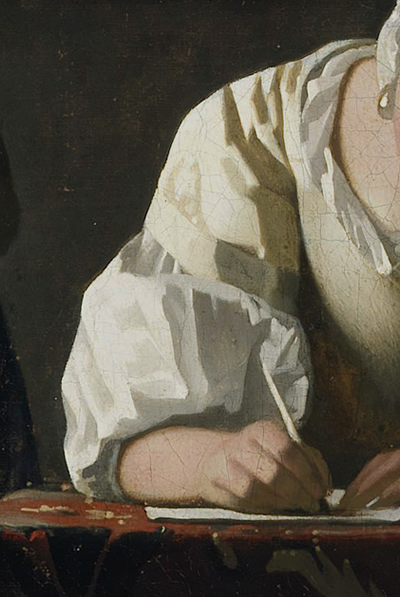Abstraction

Johannes Vermeer
c. 1670–1671
Oil on canvas, 71.1 x 58.4 cm.
National Gallery of Ireland, Dublin
As Vermeer's mastery of painting technique progressively increased into the final years of his career, his stylistic concerns shifted from the faithful recording of rea's appearances to the representation of a purified vision of the world in which his own pictorial instinct became a visible component. No detail can represent the departure from the former naturalistic vision more than the rendering of the candid starched linen sleeve of the mistress in the late Woman Writing a letter with her Maid.
If this peculiar passage is isolated from its context, the viewer is at odds to understand just what is being represented. Vermeer's painting technique has reached an extreme of economy: paint layers are meager in substance and tonal values have been reduced to a paltry few. In various parts of the composition, the brownish underpainting appears through thinly painted shadows.
The bizarre mosaic of flat shapes, carved with knife-like precision, stands in the place of what once were the folds of satin and starched white cotton, having undergone such a severe process of abstraction that the sense of natural continuity of form is entirely lost. Nonetheless, the marks and patterns left by the brush are so convincing that, although we may question the identity of what has been represented, we are never able to question its authenticity.

In Vermeer's earlier works, such as The Art of Painting, glimpses of abstraction can already be observed. However, in his later compositons, this tendency towards abstraction becomes a major sylisitic concern. Vermeer increasingly focused on the interplay of color patterns on objects, often foregoing detailed texture depiction in favor of a broader stylistic expression.
Of course, "abstract" is a term not to be confused in this context with modernist abstraction in twentieth-century art. Abstraction here refers to Vermeer’s tendency to simplify forms, to schematize them, often reducing them to their geometricized quintessence. This became a hallmark of his late style.Wayne Franits, Vermeer (Art & Ideas) (London: Phaidon Press, 2015), 218.
Vermeer's shift towards descriptive simplification has been interpreted in various ways. It may have been that the artist felt he had exhausted the potential of the naturalistic style prevalent in the 1660s, where the meticulous attention to form and texture had been key selling points. Alternatively, he might have aimed to cultivate an easily recognizable signature style, setting his work apart from his contemporaries whose paintings largely relied on detailed descriptions of reality and shared motifs. Another possibility is that, in light of economic hardships, by employing broad patches of light and dark, the painter could essentially bypass the time-consuming details which, however, had been a hallmark of the high-genre idiom in which he had previously worked and found success.
In any case, the increased stylization and refinement of the painter's late work was not unique to him. Walter Liedtke pointed out that several successful genre painters of the period, not to mention the classicist history painter Gerard de Lairesse (1641-1711), moved away from illusionism and towards abstraction, decoration, or stylization, as is obvious in the oeuvres of Samuel van Hoogstraten, Frans van Mieris, Caspar Netscher (l639?-l684), Eglon van der Neer (c. 1635-1703), and the Delft painters Cornelis de Man (1621-1706) and Johannes Verkolje (1650-1693).Walter Liedtke, Vermeer: The Complete Works (London: Abrams, 2008), 50.
While Liedtke's observation may be valuable in contextualizing the technical evolution of Vermeer's later works, it is important to note that none of the works by the painters in question display a level of abstraction that contradicts the primary goal of seventeenth-century Dutch fine painting: recognizability.